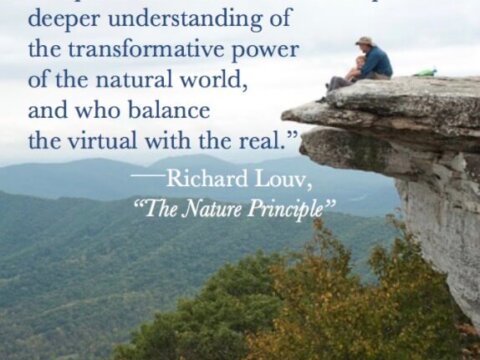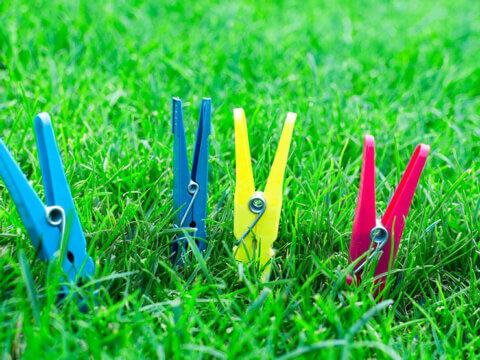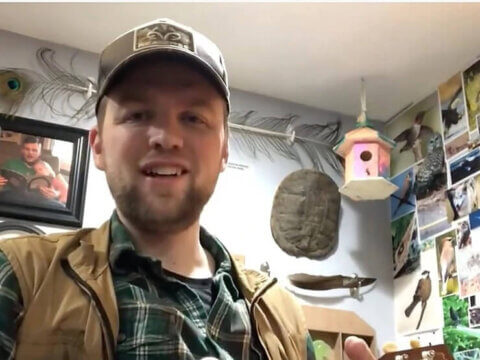Forging Latinx cultural connections through art and nature
With unwavering determination, environmental educator Amanda Segura set her sights on a remarkable vision: creating a sanctuary of learning, a nature preschool, in the heart of South Carolina. Fully aware of the profound impact that nature-based programs can have on young minds, Amanda dreamed of unveiling the very first nature preschool in the state. As the Garden Education Manager at Riverbanks Zoo & Botanical Garden, Amanda embarked on a bold venture, giving life to an extraordinary nature preschool nestled within the zoo’s 170-acre campus.
“When children engage in Riverbanks Nature Preschool, they become part of a program that makes it our mission to connect them to nature and culture,” Amanda said. “Our goal is to immerse the children in the natural world, allowing them to spend a significant portion of their day outdoors.”
Riverbanks Nature Preschool in South Carolina has transformed its educational approach by integrating diverse cultural traditions and perspectives into its programming. In collaboration with the South Carolina Commission for Minority Affairs and Palmetto Luna Arts, this preschool has established itself as a distinct environment where nature, art and culture converge to create a unique and enriching experience for children.

Surrounded by the beauty of the zoo and botanical garden, the preschoolers embark on outdoor adventures, explore nature trails, encounter animals and engage with nature. A day at Riverbanks Nature Preschool includes a walk to the botanical garden to search for the best muddy puddle and then a stop at the pond where the children visit their favorite turtles. This approach, Amanda emphasizes, offers flexibility and abundant learning opportunities that spark curiosity and creativity.
Amanda’s passion for nature and children and her background in horticulture and environmental science laid the foundation for the nature-based curriculum at Riverbanks Nature Preschool. She recognized the significance of connecting children with the outdoors and the research supporting the benefits of outdoor learning experiences. Inspired by similar programs in the Northwest, Amanda was eager to build out this program in the South.
Amanda’s involvement with the preschool has evolved over time. In the initial years, she was not only the founder but also an everyday teacher, actively engaging with the children in the forest. Now, Amanda has transitioned into a support role while still maintaining a presence in the classroom. She assists the team of preschool teachers in acquiring necessary resources and connects them with professionals and artists in the community.

As the program grew, Amanda was eager to integrate and celebrate cultural practices and identities. A natural partnership opportunity arose because Amanda’s husband, Ivan Segura, who is of Mexican heritage, serves as the Executive Director of Palmetto Luna Arts and as the Program Manager for the Hispanic/Latino Affairs Division at the South Carolina Commission for Minority Affairs.
“We strongly believe in using arts and culture to bring communities together and to educate the community at large about our culture and heritage,” Ivan said. “While we share interesting aspects of our arts and culture, we are building bridges that allow people to understand not only our background but also to realize that in the end, we are all similar and looking for a better future.”
One of the first cultural traditions introduced at Riverbanks Nature Preschool was creating “alebrijes,” a Mexican art form involving the carving of wood into imaginative or mythical creatures.
Amanda described the process, saying, “Because we’re outdoors, the kids already were noticing sticks and trees with knots and things that looked like eyes, so we got an artist that does this artwork in his spare time, and the kids were excited about this.” The children had the opportunity to observe and appreciate the shapes and forms in nature and then create their own mythical beings or creatures using water-based paint and recycled tree limbs.

“The children would paint eyes on the branches, and once they painted an eye where a branch had been cut or in a knot on the trunk, the eye is what really brought that creature to life for them,” Amanda said. Through this initial activity, many of the children who were not of Latinx heritage could learn about Latinx culture and traditions from artists.
“By including Latinx arts and culture into the Riverbanks preschool program, we are allowing those children to experience the many artistic expressions and cultural traditions from people in their own communities,” Ivan said. This approach fosters empathy, respect and curiosity.
Ivan continued, “It is exposure at an early age that will help them to become better people, with a better understanding of our cultural differences and also a knowledge of what brings us together as human beings.”

As Riverbanks Nature Preschool approaches its fifth year, demand for the program continues to grow. Parent response has been tremendous, reflecting the community’s appreciation of the preschool’s unique approach that acknowledges and celebrates cultural backgrounds.
“The families have given us positive feedback, and [the program has] helped them to open the door to talk about some cultural traditions that they either might not be familiar with or might not have felt as comfortable to talk about on their own,” Amanda said. “[This] has helped to give parents both the cultural competency and the vocabulary to talk to their kids.”

Ivan notes that, as the number one tourist attraction in South Carolina, the Riverbanks Zoo has thousands of visitors every year and is a powerful role model in the region. “Having these three remarkable organizations working together is not only a best practice but also a precursor for other groups working together in different areas of our state,” Ivan said.
Looking ahead, Riverbanks Nature Preschool aims to continue its growth and impact on the community. Amanda envisions further expansion of the program including activities from a variety of cultures represented in South Carolina, such as the local Gullah community.

Riverbanks Nature Preschool exemplifies how early childhood education can embrace cultural diversity and connect children with the natural world. Through their commitment to outdoor learning, cultural integration and collaborative partnerships, they nurture young minds and foster a sense of wonder, curiosity and appreciation for culture and the natural environment. The preschool serves as an inspiration for educators and communities seeking to plant seeds of understanding and respect in the hearts of future generations.
4 Comments
Submit a Comment
Nature Future art gallery: Kids’ visions for a just and nature-filled world
Research Digest: Nature and Art
Watershed School keeps kids connected to nature, at home, a Finding Nature News story
A common thread: Indigenous-led foundation weaves together activism and art, climate and community, a Finding Nature News story
Research Digest: Latinx Studies
Vámonos Outside is getting Latinx youth into the rivers and onto the slopes, a Finding Nature News story
That’s nice, mija: Finding common language in nature connections, a Finding Nature News story
-
Voices
CAMPING WHILE PARENTING: A Mother-Son Adventure
-
Feature
A common thread: Indigenous-led foundation weaves together activism and art, climate and community
-
Network News
Community Spotlight: Prescribe Outside
-
Voices
That’s nice, mija: Finding common language in nature connections
-
Richard Louv
"HUMMINGBIRD PARENTS": Seven Actions Parents Can Take To Reduce Risk And Still Get Their Kids Outside







Thanks for this article.
From the perspective of inclusion, cross cultural integration and creativity this is a wonderful idea and the art work is simply beautiful. I wonder if more consideration could had been given to the way nature was ‘used’ as a tool here and some of the resources selected for the art work. Bringing items such as paint into a natural environment will always have a negative impact.
My intention isn’t to be negative but to bring this conversation to the front of our consciousness: if we continue to ‘use’ nature for our own human development surely we’re perpetuating the same approach that brought us to this stage in the ecological crisis?
Is there a way that ‘being’ with nature could enhance this cross cultural relationship rather than ‘using’ nature?
Thank you, Danny, for your insight. We appreciate your perspective and wholeheartedly support the concept of being in a relationship with nature, vs. using nature.
Peaceful Gatherings Nature School started the same time as this program and serves infants through 12th grade with both half and full day options. I highly recommend checking them out as well.
They also support a community of diversity and inclusion and have several Spanish speaking teachers on staff. They are incredibly passionate about supporting neurodiverse children and families. Finding their program has been life changing for our sons.
Thank you, Carey, for sharing information about Peaceful Gatherings Nature School. We are excited to learn more about their approach!